
The rufous hummingbird is a small hummingbird, about 8 cm (3.1 in) long with a long, straight and slender bill. These birds are known for their extraordinary flight skills, flying 2,000 mi (3,200 km) during their migratory transits. It is one of nine species in the genus Selasphorus.

Anna's hummingbird is a North American species of hummingbird. It was named after Anna Masséna, Duchess of Rivoli.
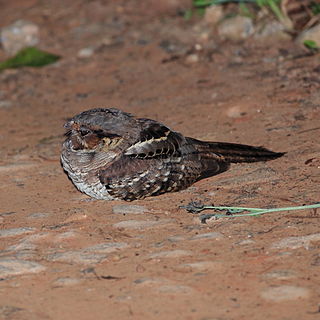
Nyctidromus is a genus of nightjars in the family Caprimulgidae. The species are widely distributed in Central and South America.

The Oriental grosbeaks (Eophona) are a genus of finches containing two species: The genus was introduced in 1851 by the English ornithologist and bird artist John Gould. The name Eophona is derived from the classical Greek words ēōs meaning "dawn" and phōnē meaning "shout" or "cry".

The blue-tailed emerald is a hummingbird in the "emeralds", tribe Trochilini of subfamily Trochilinae. It is found in tropical and subtropical South America east of the Andes from Colombia east to the Guianas and Trinidad, and south to northern Bolivia and central Brazil.
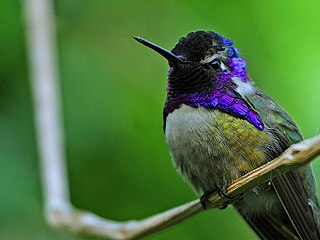
Costa's hummingbird is a bird species in the hummingbird family Trochilidae. It breeds in the arid region of the southwest United States and northwest Mexico; it winters in western Mexico.

Chalcophaps is a genus of small doves, commonly called emerald doves, that are found in Indomalaya and Australasia.

The Brazilian ruby is a species of hummingbird in the "brilliants", tribe Heliantheini in subfamily Lesbiinae. It is endemic to Brazil.

Chlorostilbon is a genus of hummingbird in the family Trochilidae, known as emeralds. A single species, the blue-chinned sapphire is variously placed in the monotypic genus Chlorestes or in Chlorostilbon. The taxonomy of the C. mellisugus superspecies is highly complex and, depending on view, includes 1-8 species. All species in this genus have straight black or black-and-red bills. The males are overall iridescent green, golden-green or bluish-green, and in some species the tail and/or throat is blue. The females have whitish-grey underparts, tail-corners and post-ocular streak.

The swallow-tailed hummingbird is a species in the hummingbird family (Trochilidae), found mainly in east-central South America. Most authorities place it in the genus Eupetomena, although some place it in Campylopterus based on song and the thick shafts of the males' first primaries. Its common name and specific epithet both refer to the long, deeply forked, somewhat swallow-like tail.

Eupetomena is a genus in the hummingbird family Trochilidae. It contains two species which are both found in eastern South America.

Heliodoxa is a genus of hummingbirds in the family Trochilidae.
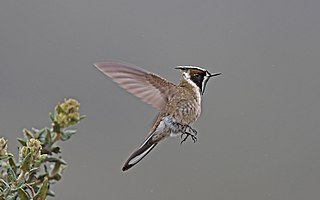
The bearded helmetcrests (Oxypogon) are a genus of hummingbird in the family Trochilidae. They are found in Colombia and Venezuela. Primary natural habitat is subtropical or tropical high-altitude grassland, known as páramo. The genus contains four species.

Woodnymphs are hummingbirds in the genus Thalurania. Males are green and violet-blue, while females are green with white-tipped tails and at least partially whitish underparts. Both sexes have an almost straight, entirely black bill and little or no white post-ocular spot. They are found in forest and tall second growth. The species in this genus are almost entirely allo- or parapatric, and a species is present virtually everywhere in the tropical humid Neotropics.

The pale-tailed barbthroat is a species of hummingbird in the family Trochilidae. It is found throughout much of the Amazon Basin from the eastern Andean foothills to the Atlantic Ocean.
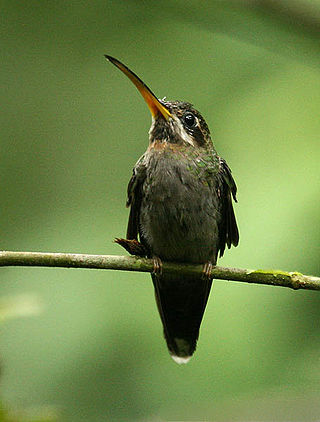
The barbthroats are a genus Threnetes of South American hummingbirds in the family Trochilidae.

The rufous-gaped hillstar, formerly included in the white-tailed hillstar, is a species of hummingbird in the "brilliants", tribe Heliantheini in subfamily Lesbiinae. It is found in Colombia and Ecuador.
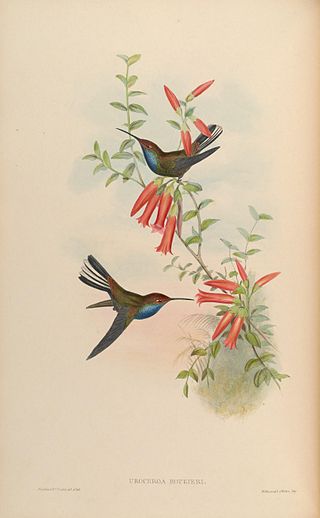
Urochroa is a genus of hummingbird containing two recently-split species.
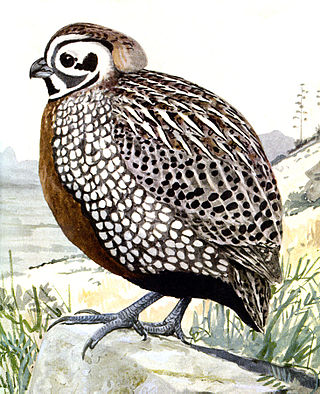
Cyrtonyx is a bird genus in the New World quail family Odontophoridae.

Atticora is a genus of bird in the swallow family Hirundinidae that are found in South America.




















